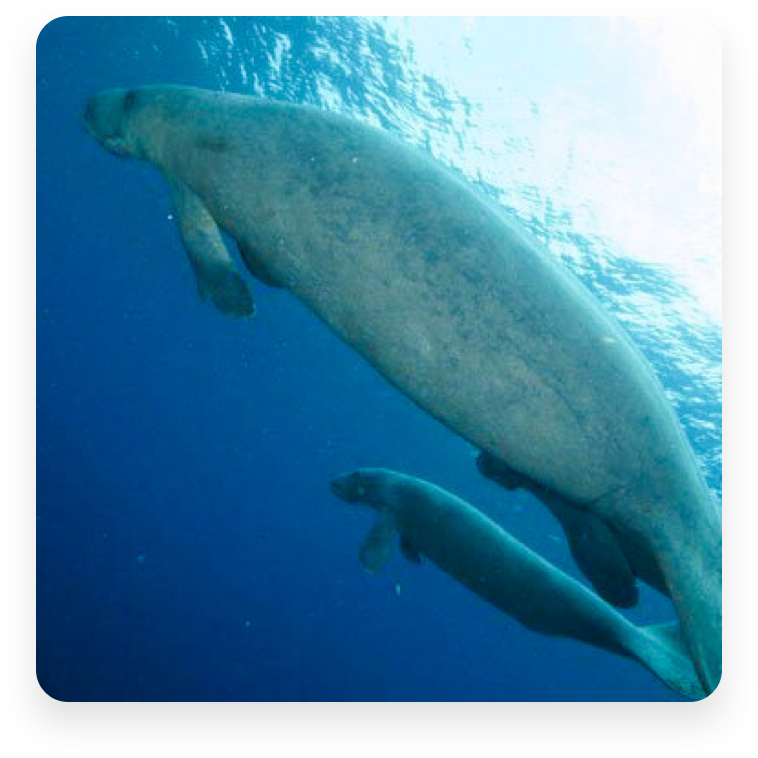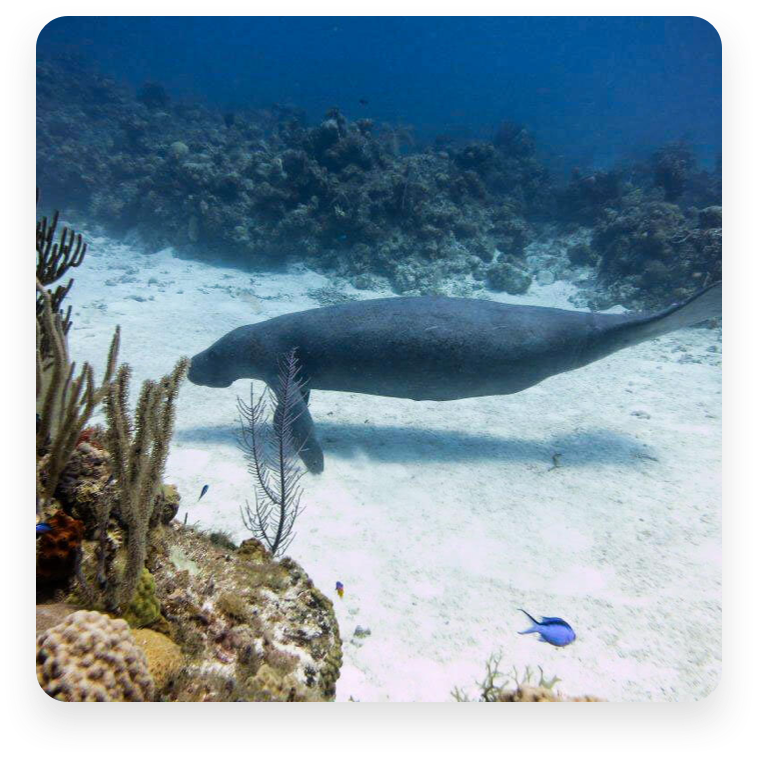How a Team of CMA Research Institute and Cuban Scientists are Building the Foundation to Conserve Manatees in Cuba

Cuba Manatee Conservation
Very little is known about manatees in Cuba, although it has some of the most extensive and best manatee habitat in the Caribbean. In 2001, Dr. James “Buddy” Powell began a long-term initiative to develop and strengthen a manatee research and conservation program in Cuba. Working in collaboration with several partners and under a license from the U.S. Treasury Department, Dr. Powell and the research team have facilitated surveys in various sections of the island and helped to facilitate manatee research and conservation initiatives. This is the only in-depth and long-term study of manatees ever conducted in Cuba.
Today, Cuba, with its extensive coastline, protected, shallow bays and massive seagrass meadows, possesses the most important habitat for manatees in the Caribbean. These shallow, sheltered coastal and estuarine habitats are home to a high diversity of species and endangered animals. Causes for depletion of the Antillean manatee in Cuba are poaching and entanglement in fishing gear. Lack of awareness enhances this situation in most coastal communities throughout the island. The overall aim of this program is to contribute to the conservation of manatees and its habitats and to instill environmental awareness.
CMA Research Institute’s project is working with Cuban scientists in order to (1) establish baseline manatee population numbers in Cuba; (2) help Cuba strengthen protections for this remarkable and endangered species, and (3) determine the degree of genetic exchange between Cuban manatees and those in Florida and the wider Caribbean. We already have evidence of Florida manatees traveling to Cuba and suggest that there may be some population exchange between the two countries.
Manatee Distribution, Abundance and Habitat Use
A monitoring program has been implemented in the Fauna Refuge “Ciénaga de Lanier”, Isla de la Juventud, for the past seven years. It began as a pilot study in order to develop a survey protocol that could be easily replicable for other areas. This program has been significant due to the lack of scientific research previously implemented in the country as a result of the high cost of some survey techniques and remoteness of certain manatee areas. As a consequence of this, essential information is missing from the National System of Protected Areas (NSPA) to effectively accomplish manatee survival. The results obtained up to date have provided a baseline about manatee presence and key habitats inside “Ciénaga de Lanier”, an MPA with a local, national, and international importance. It has been estimated a number of 20 to 30 animals using this area, which ensure important resources such as fresh water input, refuge and vegetation. Connectivity among different habitats in this region needs further evaluation in order to locate possible manatee sanctuaries. The methods used in this MPA were approved and presented as a protocol by the NSPA to be used in other regions throughout Cuba, which we believe is one of the most important outcomes of this work.

Tagging Program
In 2012, CMA Research Institute (then known as Sea to Shore Alliance) became the first organization ever allowed to satellite tag marine mammals in Cuba. Two female manatees were tagged in early July and their movements were mapped in a partnership project with the University of Havana’s Center for Marine Research (CIM) in Cuba. These animals have led researchers to new areas that may be important manatee habitats. This project took more than two years of preparations and approvals between the U.S. and Cuban governments. More tags need to be acquired and exported to Cuba in order to better understand manatees movements and habitat use, and the effectiveness of the network of marine protected areas.
A team of researchers caught seven manatees during several weeks of field activity in 2012-2013 centered on the “Isla de la Juventud” off Cuba’s Southwest coast. Genetic samples were gathered from each of the seven manatees; data from those samples will help researchers further our knowledge about relatedness between individual manatees and how the population of manatees in Cuba are related to those in Florida, the Caribbean, and Central America.
Help Support Manatee Research
Stranding and Sighting Network
Cuba has a network of people and institutions working together to report marine mammal mortality events. The country possesses a database of manatee mortality events from 2001-2014. Additionally, with the capacity built through three necropsy workshops and several meetings, there is now a team capable to respond to most of these mortality events. Nonetheless, there still remain many inaccessible areas that need to be included in this network.
A significant outcome of this work has been the collection of biological samples for genetic and morphological studies. To date, several manatee samples (bones and tissue) have been collected and will be used to understand the genetic structure of manatees in Cuba, diagnose their status, and assess the relationship of this population with others in the Caribbean, as well as its subspecies in Florida.
The program is also working on instilling a nationwide network of information, involving locals in coastal communities, tourists, fishermen, marine protected area and other institutions around the country in order to gather information about manatee sightings. Thanks to this hub of collaborators, it has been collected sightings information from manatees, bottlenose dolphins, and orcas from across the archipelago, including photographs and film footage. This is extremely significant as before this project no photographs of Cuban manatees in the wild existed.
Genetic Research
Preliminary genetic analysis generated information regarding the mtDNA haplotype composition of the manatee (T. manatus) from Cuba. Two haplotypes have been identified so far. Haplotype A1, found in Florida, Mexico, the Dominican Republic and Puerto Rico, was the most frequent haplotype and widely distributed. The second haplotype A3, previously referred to as endemic from Belize, was identified from an individual stranded in “Isabela de Sagua”, Villa Clara province, north of Cuba. This analysis continues as new manatee samples have been collected and the higher the number of samples the more accurate the results will be.
Education and Awareness
CMA Research Institute’s work encourages action directed to increase awareness among local population and institutions. This will contribute to mitigate threats with education and transformation of local perception and attitudes. Different activities involve work with children in marine festivals. Public service announcements ran on national television, discussing the conservation of marine life; each one focused on a different species (sea turtle, manatee, and shark) and used professional dancers to mimic the movements of the animals in an extremely artistic and creative way. This television spots entitled, with the Spanish slogan “Siéntelo en tu Piel” (Feel it in your skin), were very well-received and the Cuba team is now working to raise additional funding to broaden their reach.

Summary of Impacts
- Through grant funds received from donors and partners, this program has been able to work with multi-institutional partners to establish strategic and cooperative initiatives that increased the scientific understanding about manatees and other endangered coastal species. Such partners included the Center for Marine Research (CIM-UH), the National System of Protected Areas (NSPA), and the National Enterprise for Flora and Fauna (NEFF).
- Educational activities and initiatives aim at instilling awareness in the Cuban nation; the ultimate goal is to turn manatees into a flagship species for the country conservation programs.
- A National Manatee Sighting and Stranding Network has been designed, developed, and implemented with the aim of increasing information about the distribution and threats for this species in Cuba. The network has allowed for the recording of manatee deaths and sightings all along the Cuban Archipelago, thereby making an important contribution to conservation among local coastal communities and management agencies in Cuba.
- Around 60 samples have been collected to assess the manatee genetic diversity in Cuba and its relatedness with Florida and other populations around the Atlantic. This work is being developed by a Cuban biologist in the USGS laboratories with the support of CMA.
Description
The Antillean manatee is a subspecies of the West Indian manatee as is the Florida manatee.
- All West Indian manatees share these characteristics:
- they are gray or brown with two flippers that have 3-4 nails (they don’t really hold food with their flippers except in captivity when they’re fed lettuce). The females are larger than males. The Antillean manatee is slightly smaller than the Florida manatee.
- What They Eat
- The Antillean manatee is primarily herbivorous and feeds on a wide variety of submerged, floating, and shoreline vegetation.
- Weight
- 440 to 1,320 lbs.
- Length
- 8.5 – 11.5 feet
- Greatest Threats
- Human threats include entanglement in fishing gear, hunting – though it is illegal and lack of public awareness of how to protect this gentle marine animal. All manatees face the threat of injury or death from cold stress if they lack access to warm waters.
Making Waves
- 1600+ rescued sea turtles since 2010
- 2100+ Nests monitored since 2010
- 850+ Animals released since 2010
- 190K Volunteer Hours 2020-2021